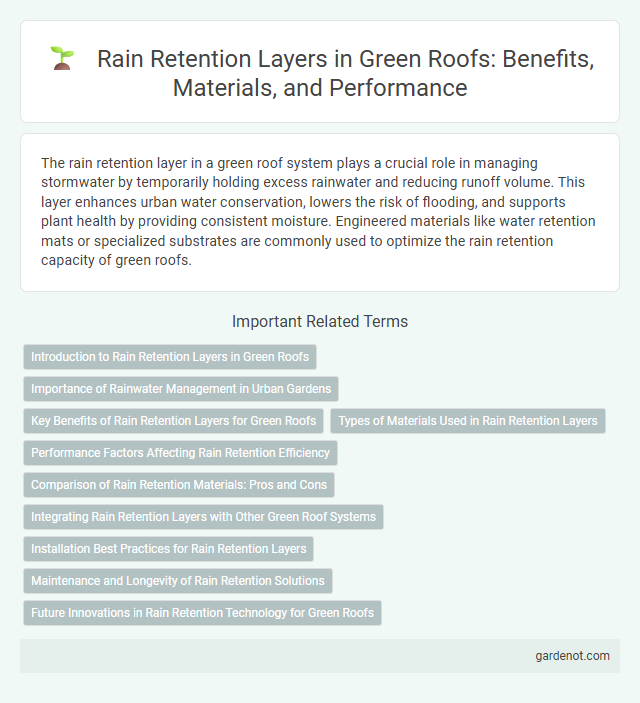The rain retention layer in a green roof system plays a crucial role in managing stormwater by temporarily holding excess rainwater and reducing runoff volume. This layer enhances urban water conservation, lowers the risk of flooding, and supports plant health by providing consistent moisture. Engineered materials like water retention mats or specialized substrates are commonly used to optimize the rain retention capacity of green roofs.
Introduction to Rain Retention Layers in Green Roofs
Rain retention layers in green roofs play a critical role in managing stormwater by temporarily holding and slowly releasing rainwater, reducing runoff and decreasing the load on urban drainage systems. These layers typically consist of lightweight materials such as expanded clay, perlite, or engineered retention mats designed to maximize water absorption and retention capacity. Effective rain retention layers enhance the overall sustainability and performance of green roofs by promoting natural water cycles and mitigating flood risks in urban environments.
Importance of Rainwater Management in Urban Gardens
The rain retention layer plays a critical role in urban garden green roofs by absorbing and temporarily storing rainwater, reducing runoff volume and mitigating flooding risks. Effective rainwater management enhances soil moisture balance, promoting plant health and extending the lifespan of rooftop vegetation. Incorporating a high-capacity retention layer supports sustainable water management practices crucial for urban environments facing increased stormwater challenges.
Key Benefits of Rain Retention Layers for Green Roofs
Rain retention layers in green roofs enhance stormwater management by absorbing and temporarily storing rainwater, reducing runoff and lowering the risk of urban flooding. These layers improve water quality by filtering pollutants and enabling gradual release of clean water, benefiting surrounding ecosystems. Their water retention capacity supports plant health during dry periods, promoting sustainable vegetation growth and extending the lifespan of the green roof system.
Types of Materials Used in Rain Retention Layers
Rain retention layers in green roofs commonly utilize materials such as expanded clay, perlite, and vermiculite for their lightweight and high water-holding capacities. Synthetic geotextiles and drainage mats made from recycled plastics enhance water retention while providing structural support and filtration. Innovative rain retention systems also incorporate bio-based materials like coconut coir to improve sustainability and increase moisture retention efficiency.
Performance Factors Affecting Rain Retention Efficiency
The rain retention layer in green roofs significantly influences water retention capacity through factors such as material permeability, thickness, and compaction level. High-performance layers utilize lightweight, porous substrates that maximize absorption while preventing waterlogging and structural strain. Optimizing these parameters enhances stormwater management and reduces runoff, contributing to urban flood control and environmental sustainability.
Comparison of Rain Retention Materials: Pros and Cons
Rain retention layers in green roofs commonly utilize materials like expanded clay, perlite, and basaltic lava, each offering distinct advantages and limitations. Expanded clay provides high water retention and durability but can be heavier and more expensive, while perlite is lightweight and cost-effective yet less durable and water-retentive. Basaltic lava offers excellent porosity and thermal insulation but may have higher initial costs and variable availability depending on the region.
Integrating Rain Retention Layers with Other Green Roof Systems
Rain retention layers are essential for enhancing water management in green roofs by temporarily storing stormwater and reducing runoff volume. Integrating these layers with drainage, growing medium, and vegetation systems improves overall roof performance by optimizing water retention and promoting plant health. Proper coordination among these components ensures efficient water absorption, slows runoff release, and supports sustainable urban drainage solutions.
Installation Best Practices for Rain Retention Layers
Proper installation of the rain retention layer in green roofs involves using materials with high water retention capacity, such as specialized mats or expanded clay aggregates, to optimize stormwater management. Ensuring even distribution and secure placement prevents displacement during heavy rainfall or strong winds, maximizing retention efficiency. Incorporating appropriate drainage layers beneath the retention layer helps control excess water flow, safeguarding roof structure integrity and plant health.
Maintenance and Longevity of Rain Retention Solutions
The rain retention layer in green roofs plays a crucial role in managing stormwater by temporarily storing rainwater and reducing runoff. Regular maintenance, including debris removal and inspection for membrane integrity, ensures optimal water retention capacity and prevents clogging or leaks that could compromise the system's performance. Proper upkeep significantly extends the longevity of rain retention solutions, enhancing the overall sustainability and efficiency of green roof installations.
Future Innovations in Rain Retention Technology for Green Roofs
Future innovations in rain retention technology for green roofs emphasize advanced materials such as bio-based water-absorbing polymers and smart hydrogels that enhance stormwater management efficiency. Integration of sensor-driven systems enables real-time monitoring of moisture levels, optimizing water retention and release cycles to reduce runoff and improve plant health. Emerging designs also focus on modular, lightweight layers that maximize retention capacity while supporting structural stability in urban environments.
Rain retention layer Infographic

 gardenot.com
gardenot.com